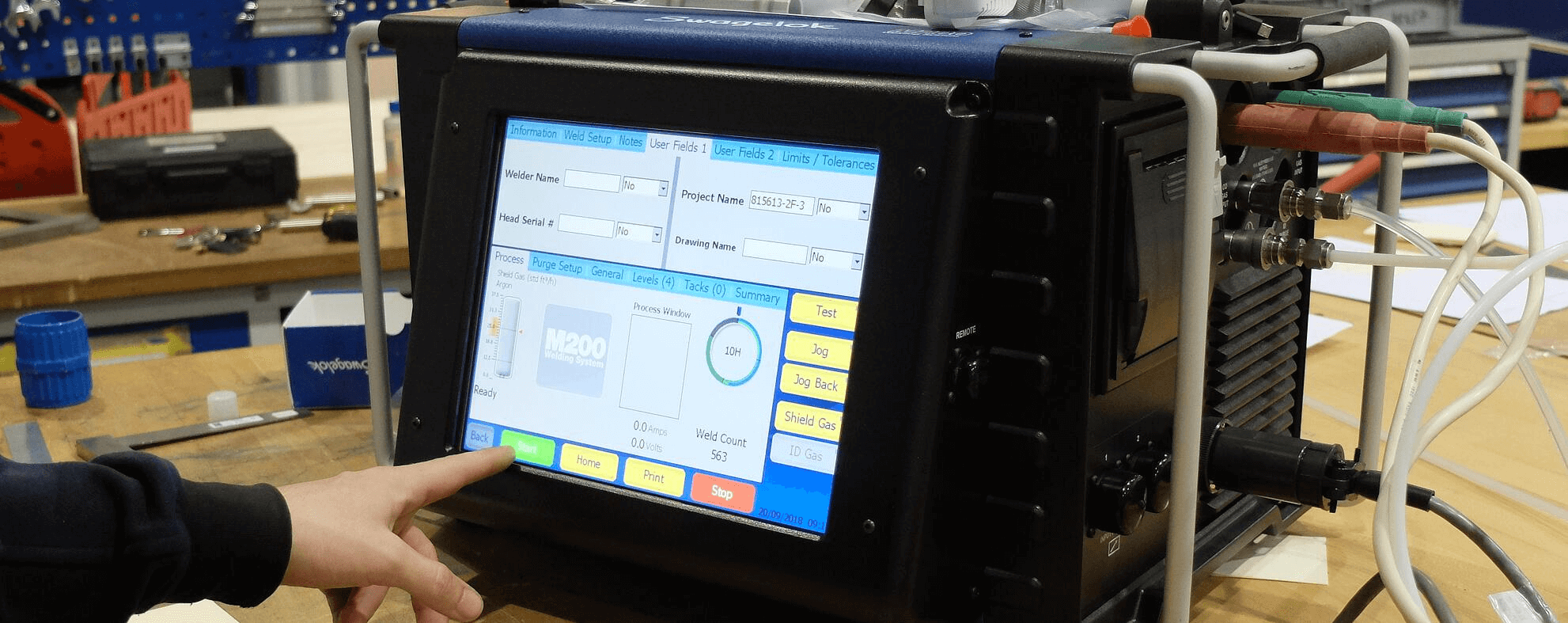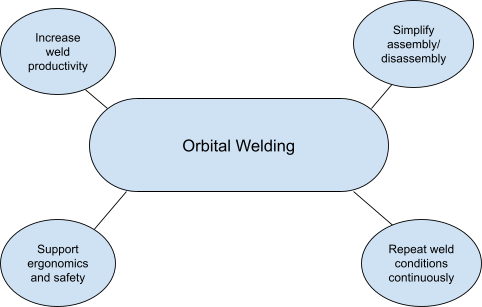Learn more about orbital welding basics and train your team on a fast & efficient welding process.
 Welding plays a critical role throughout numerous industrial applications. Different material considerations such as base metal and thickness will determine which welding procedure best suits the workpiece: Stick, MIG/Flux Core, or TIG. Operator ability can also serve as a throttling factor, as TIG specifically is an incredibly difficult practice.
Welding plays a critical role throughout numerous industrial applications. Different material considerations such as base metal and thickness will determine which welding procedure best suits the workpiece: Stick, MIG/Flux Core, or TIG. Operator ability can also serve as a throttling factor, as TIG specifically is an incredibly difficult practice.
For certain industries, weld failure not only poses an interruption to processing but could carry additional danger by releasing liquids or gasses that are highly flammable and detonable in closed spaces. However, even the most skilled welders will encounter certain jobs that demand the usage of an orbital welding setup to accurately determine weld quality on the fly or for challenging spaces where a human operator would not be able to perform adequately. Any industry that may require welding services would do well to have its associated welders undergo orbital welding training basics to serve as an additional tool in their repertoire.
Orbital welding can best be thought of as a mechanical stand-in for gas tungsten arc welding (GTAW), more commonly known as tungsten inert gas welding (TIG). TIG operation uses a non-consumable tungsten electrode with an inert gas (typically argon or helium) to protect the weld puddle from atmospheric gasses, which contribute to porosity and other poor weld characteristics. For welds that require a filler rod, the operator uses their free hand to add the filler metal to the workpiece. Traditional power supplies are operated with a foot pedal to supply the current to initiate and maintain the arc necessary to create the puddle.
The operation is complex, and small changes in distance and angle between the electrode and filler metal can result in shorts and impurities introduced to the weld bead or tungsten electrode. No matter how steady one’s hands and feet are, certain jobs require the use of an orbital welding rig to create welds that will meet ASME standards.
In orbital welding, the arc is rotated about a static workpiece, improving welding speed on complex jobs such as pipe welds while eliminating error due to human movement. Orbital welding invokes the operator’s weld knowledge and leaves the technical skill to the machinery. This allows the operator to precisely control the parameters of the weld, such as the arc length, current pulse frequency, and welding speed, to create an exact and repeatable weld.
As with any weld, verification of an orbital weld will take into consideration multiple factors. A coupon will be subjected to the same weld parameters as the workpiece. These coupons undergo destructive analysis, which allows for deeper inspection of the weld to determine full penetration of the bond as well as an examination of bead width consistency. Any adjustments of weld variables during operation should also submit a test coupon to ensure proper metal joining.
Here’s a comparison of GTAW/TIG and orbital welding:
| GTAW/TIG | Orbital Welding |
| Slow deposition rate | Faster deposition rate due to automation |
| Difficult weld style equates to high compensation for professional work | Machine operation reduces the skill barrier for entry |
| Welding feasibility in part relies on space around the weld and human positioning | Welding feasibility greatly increases as the only consideration is having enough space around the workpiece to mount rig |
| Certain conditions may increase the difficulty of weld or make it outright impossible | Some conditions can be successfully surmounted as the orbital welding unit can account for low light, wind, etc. |
| Safety of welder is paramount; external factors may also extend job time | The operator controls the unit at a distance; safety is maximized |
| In addition to being in demand, professional TIG welders can be scarce | Orbital welding training basics can be instructed in a relatively short amount of time |
Orbital welding involves a balancing act between surface tension and gravitational force at different angular positions during rotation. Orbital welding training equips the operator to be conscious that certain starting characteristics of the weld may change during the rotation of the arc; this is similar to the ingrained changes a welder must perform when manually switching between weld positions. With the proper training, the operator is able to adjust the weld parameters to an extremely fine level of detail during operation, which coupled with feedback from coupon analysis allows for essentially perfect repeatability between jobs. An even further level of control exists: feedback systems provide real-time measurements of the physical qualities of the puddle. Just as when operating a hand torch, cleanliness and regular maintenance of the rig and its components are key to ensuring the purity of the weld head and the shielding gas’ efficacy.
 Controlling a weld at such a granular level allows for numerous benefits. A highly repeatable process reduces total weld time once an operator is able to determine the exact specifications for a particular job that may occur tens or hundreds of times. A properly performed weld will be confirmed by coupon analysis; assuming welding variables remain constant throughout the course of the job, an inspection of a single weld suffices for all. Moreover, confirmation of a proper weld at the beginning of work eliminates the need for rework.
Controlling a weld at such a granular level allows for numerous benefits. A highly repeatable process reduces total weld time once an operator is able to determine the exact specifications for a particular job that may occur tens or hundreds of times. A properly performed weld will be confirmed by coupon analysis; assuming welding variables remain constant throughout the course of the job, an inspection of a single weld suffices for all. Moreover, confirmation of a proper weld at the beginning of work eliminates the need for rework.
A proper weld is crucial for certain industries where leakage may not only result in a loss of valuable product, but also emission of a very potent and easily ignitable fuel source. Perhaps as important as the seal is the reduction or practical elimination of spatter during welding, which introduces a possible point of contamination in systems. Spatter, expelled metal during welding that does not form part of the weld joint, often shows as slight bumps in the workpiece about the joint. Spatter usually forms as spherical beads, which can hinder cleaning at appreciable sizes and densities of concentration.
A further potential hazard could be the possibility of spattering flaking from the workpiece over time. Orbital welding prevents spatter to non-appreciable levels via precise control of welding variables. Beyond applications where cleaning and sterilizing surfaces are necessary, a smooth interior surface helps prevent blockage and corrosion while reducing drag.

Perhaps an understated benefit of orbital welding is best felt by the operator themself. Less time spent performing welds at difficult angles requiring large amounts of physical exertion protects the health and safety of your weld team. As orbital welding is a continuous action about the workpiece, additional time is saved as there is no need for disassembly around and including the workpiece. So long as the welding head and rig fit in the space provided, orbital welding eliminates time spent on disassembly and reassembly of the surrounding equipment.
Additionally, work environments where welding would be difficult due to external conditions such as wind or visibility become relatively trivial with an orbital welding rig. In extreme cases, the presence of hazardous materials could completely rule out any chance of a human operator performing the weld. An orbital welding rig should be seen as a necessity in many industries that helps operators perform challenging, repeatable welds with consistency. The sooner an operation has its team instructed on orbital welding training basics, the sooner they can reap the rewards of a speedy and highly reproducible welding technique.
Any welder can tell you the challenge of TIG welding. Compared to point-and-shoot methods, it is closer to an art with the high level of fine precision required to operate, much less create a weld that stands up to exacting industrial standards. While orbital welding can’t replace the skilled hand of a welder in every job, it can significantly increase the productivity of your team while providing high-quality welds for repeatable jobs in your operations. Consult with our Field Advisors to determine the benefits of an orbital welding rig in your system.

Lorem ipsum dolor sit amet, consectetur adipiscing elit. Suspendisse tempor nisi ut vehicula commodo.
Learn More →
Lorem ipsum dolor sit amet, consectetur adipiscing elit. Suspendisse tempor nisi ut vehicula commodo.
Learn More →
Lorem ipsum dolor sit amet, consectetur adipiscing elit. Suspendisse tempor nisi ut vehicula commodo.
Learn More →
Lorem ipsum dolor sit amet, consectetur adipiscing elit. Suspendisse tempor nisi ut vehicula commodo.
Learn More →
Lorem ipsum dolor sit amet, consectetur adipiscing elit. Suspendisse tempor nisi ut vehicula commodo.
Learn More →
Lorem ipsum dolor sit amet, consectetur adipiscing elit. Suspendisse tempor nisi ut vehicula commodo.
Learn More →
Lorem ipsum dolor sit amet, consectetur adipiscing elit. Suspendisse tempor nisi ut vehicula commodo.
Learn More →
Lorem ipsum dolor sit amet, consectetur adipiscing elit. Suspendisse tempor nisi ut vehicula commodo.
Learn More →
Lorem ipsum dolor sit amet, consectetur adipiscing elit. Suspendisse tempor nisi ut vehicula commodo.
Learn More →Swagelok is a $2B developer of industrial fluid system products and services. Swagelok Edmonton is an authorized Swagelok Sales and Service Centre serving Canadian companies in clean energy, chemical, oil and gas, and other industries. Proud member of the Canadian Council for Aboriginal Business.
Tel: 780-437-0640.
Swagelok Edmonton values your privacy. This website uses cookies to enhance user experience and analyze performance and traffic. Our policies are posted here.
Login/Register | Privacy | Safe Selection | Centre Locator | Sitemap | Legal
© 2012-2024 Edmonton Valve & Fitting Inc.